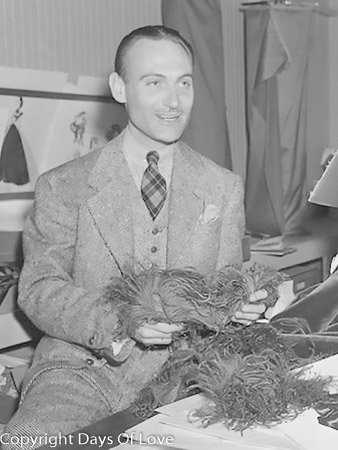

Partner Lee Plunkett
Queer Places:
University of California, Berkeley, California, Stati Uniti
 Walter Plunkett (June 5, 1902 in
Oakland, California – March 8, 1982) was a prolific
costume designer who worked on more than 150 projects throughout his
career in the
Hollywood
film industry. While nearly all of the major players were homosexuals, few
were as comfortable in the their skins as Walter Plunkett, forever remembered
as the man who designed the costumes for Gone With the Wind. "I'd say
Walter Plunkett was very at ease with who he was," said
Don Bachardy. In this, he
resembled not so much Adrian or
Travis Banton, but
Howard Greer, with whom he was
friends. "They were very much alike, Walter and Howard," said their mutual
friend Satch LaValley. "They
never pretended, nor for one minute."
Walter Plunkett (June 5, 1902 in
Oakland, California – March 8, 1982) was a prolific
costume designer who worked on more than 150 projects throughout his
career in the
Hollywood
film industry. While nearly all of the major players were homosexuals, few
were as comfortable in the their skins as Walter Plunkett, forever remembered
as the man who designed the costumes for Gone With the Wind. "I'd say
Walter Plunkett was very at ease with who he was," said
Don Bachardy. In this, he
resembled not so much Adrian or
Travis Banton, but
Howard Greer, with whom he was
friends. "They were very much alike, Walter and Howard," said their mutual
friend Satch LaValley. "They
never pretended, nor for one minute."
Born in Oakland, California, the son of James Plunkett, a dentist, and Frances Plunkett, Plunkett studied law at the University of California, where he was a member of the California-Alpha chapter of Sigma Phi Epsilon fraternity, but showed greater interest in the school's theatrical group. Shortly before graduation, his father bought him a ticket to New York and told him to give the stage a try. He moved to New York City in 1923 and began work as a stage actor as well as a costume and set designer. In the fall of 1923, Walter snagged a small part in "Out of the Seven Seas," a "crude melodrama," according to the New York Times, staged at the Frazee Theatre. In both this and his next play, "The Man Who Ate the Potomack," he played Chinamen; the latter ran at the Cherry Lane Playhouse in Greenwich Village in March 1924. It's probably this is where he met Howard Greer, who was then designing costumes for the Greenwich Village Follies. Friends have said there was a romance between them, or at least infatuation on Greer's part with the much younger Plunkett. In any event, Greer extended an invitation to follow him out to Hollywood, and Walter, discouraged with his "inability to act," accepted. After some time in Greenwich Village, he moved back to California, this time to Hollywood, and found work as a movie extra, collecting 15 dollars a week. He can be seen dancing with Irene Lentz, another future top designer, in Erich von Stroheim's 1925 film The Merry Widow. He soon made a career change to costume and wardrobe.

University of California, Berkeley, CA
Greer helped him land a job working in wardrobe at the old FBO studios. Plunkett's first duty: painting roses on the breasts of chorus girls. "No one with any pride would have taken the job," he'd recall. "but I did." At 40 dollars a week, he couldn't say no. FBO became RKO and in the interim Plunkett created an efficient, functioning wardrobe department based on Greer's model at Paramount. By the early 1930s RKO had moved away from the serials and Westerns for which FBO had been known, and Plunkett found himself designing gowns for leading ladies like Ginger Rogers in Flying Down to Rio or Katharine Hepburn in Little Women.
It was Howard Greer who suggested that Plunkett, then a stage designer, try Hollywood. Greer was, at the time, still happily esconced at Paramount, carefree and gay, in all meanings of the term. Plunkett was understandably dazzled by the older designer's good fortune, bot in terms of money and personal liberty. It was everything he had dreamed of, ever since he was a tyke acting out little play dramas in his backyard in Oakland, CA.
Plunkett's first credited work as a costume designer was the 1927 film Hard-Boiled Haggerty. At RKO, he developed a huge costume and wardrobe department that became a major studio asset. Given free rein, he set about creating costumes that rivaled the work of his contemporaries, such as Travis Banton and Adrian.
Plunkett's work contains its own flights of fancy. Take the watermelonpink dress trimmed in turquoise and rhinestones that Bebe Daniels wears in the early Technicolor film Rio Rita (1929). Decades later, he saw a print of the film and shuddered "It was hysterical," he said, "but at the time, we thought it was beautiful." Or consider the outrageous "leg-o-mutton" sleeves Irene Dunne wears in Cimarron (1931). Authentic to the period, yes, but certainly whimsical. Or, best of all, the magnificent silver metallic moth costume Katharine Hepburn wears in Dorothy Arzner's Christopher Strong. A few minutes under the hot lights and Kate was frying like a bacon.
Overworked and underpaid (just 75$ a week), Plunkett quit RKO in a huff in 1935 and went back to New York, where he worked as a designer for a shop on Seventh Avenue. But Katharine Hepburn brought him back for Mary of Scotland, and he stayed on as a freelancer.
Plunkett's best-known work is featured in two films, Gone with the Wind (1939) and Singin' in the Rain (1952), in which he lampooned his initial style of the Roaring Twenties. Yet he never felt it was his best work, considering the costumes he created for Lana Turner in Diane (1956) his apex.
In 1945, Plunkett settled in at MGM, accepting an offer from head designer Irene, his dance partner from The Merry Widow, to handle all of the studio's period pictures.
In 1951, Walter Plunkett shared an Oscar with Orry-Kelly and Irene Sharaff for An American in Paris. Satch LaValley would remember Walter uncharacteristically grumbling, "I can't believe I have to share one-third of this damn Oscar with that son-of-a-bitch Orry-Kelly." As edgy as Plunkett was easygoing, Orry was opinionated, headstrong alcoholic who could dissolve his friends into laughter and shoot down his foes with one well-timed barb. "Orry-Kelly was completely unpredictable," said his friend Robert Shaw. "One minute he was sweet and kind, making you laugh. The next he was sharpening his claws against you." The difference in style among designers can be best seen in An American in Paris. Irene Sharaff's costumes in the long ballet sequence are loud, vibrant, in many shapes and colors. Walter Plunkett's designs for the Beaux Art ball are over the top, with capes and diamond shapes everywhere. But the rest of the film, designed by Orry-Kelly, is a marvel of simple, elegant lines. Nina Foch's one-shoulder-bared, strapless white gown is stunning.
His kindness is legendary, especially tales of how he'd often go doen to the courthouse and put up bail for gay men arrested for cruising Pershing Square or Griffith Park. "That's true," insisted his friend Satch LaValley. "He'd often post bail for boys who were arrested. He didn't even have to known them. That was just part of his nature. He'd hear of some boy's story and go down and try to help."
He lived in West Los Angeles on Goshen Avenue with his devoted and much younger partner, Lee. Christpher Isherwood and Don Bachardy would visit them occasionally. "They were both into knitting." Bachardy remembered. "They knitted for their toilet seats. They knitted things all over the place."
Plunkett retired in 1966, after having worked in films, on Broadway, and for the Metropolitan Opera. He spent his last years painting, and officially adopted Lee, to whom he left his entire estate. He died at age 79 in Santa Monica, California.
My published books: